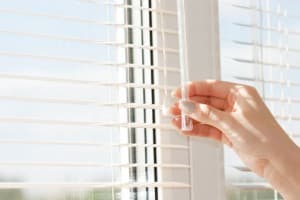 Window blinds can make great shades for your office windows. They can enhance the look of your building, offering some privacy and also serve to protect from the sun, creating a comfortable environment for everyone. On the other hand, window blinds are a great location for dust, dirt and grime to collect. Thus regular cleaning is essential to keep the dust at bay. We have put together some useful tips on not only how to clean blinds, but how to keep them clean as well.
Window blinds can make great shades for your office windows. They can enhance the look of your building, offering some privacy and also serve to protect from the sun, creating a comfortable environment for everyone. On the other hand, window blinds are a great location for dust, dirt and grime to collect. Thus regular cleaning is essential to keep the dust at bay. We have put together some useful tips on not only how to clean blinds, but how to keep them clean as well.
Wooden Venetian Blinds. It is important to note that wood blinds are to be cleaned differently than other blinds. This is for two reasons. The first reason is that most wooden blinds are made out of a very absorbent wood. This wood, when it comes in contact with liquid or water, can become warped after it is allowed to dry. Another reason is that often times they contain a layer of stain or varnish. When this stain or varnish comes in contact with water or liquid it can leave behind streaks. Thus we recommend if you have wooden blinds before you begin to clean them, take a look at what the manufacturer recommends for cleaning. Otherwise, stick to a light cleaning such as dusting or any other method that doesn’t involve using liquids.
Regular Light Cleaning. One of the best ways to clean your blinds is to dust regularly. Even though a regular light cleaning does require more work, by doing this often it can reduce the need for a very time consuming deep cleaning. The easiest method would be to dust the blinds with a duster, yet it is not the most effective. A more effective approach is to dust each slate individually. This can be done with either a micro fiber cloth, white gloves, or even an old sock. Whatever tool you choose is up to you, but the important thing to keep in mind is to do it regularly.
Vacuum Blinds. Another effective approach to cleaning blinds is to use a vacuum cleaner. One word of caution however is if the suction is too powerful it can actually suck in the blinds and possibly damage them. If the vacuum cleaner does have power settings, set to the lowest setting first and slowly move up to a more powerful setting. Be mindful to vacuum each slate individually including the underside of the slate as well.
Treating Stains. You will at some point come across grease, fingerprints, or other dirt and grime that will not come off with a mere dusting. The most effective approach is to apply a cleaner to the blinds. If you have wooden blinds, please heed the warning mentioned above. An effective cleaner for cleaning blinds is window cleaner. Window cleaner works great because it is designed to cut grease that is often on windows. That same grease can be found on your window shades as well. Simply dilute as prescribed. Dampen a micro fiber rag with the cleaning solution and wipe down blinds one slate at a time. Then use a different dry micro fiber cloth to dry the blinds. Using a different rag to wet and dry can prevent the dirt from spreading. Of course with any chemical that you are using for the first time, you want to test it in a small area first. If you notice any discoloration or staining, do not use the chemical on your blinds.
Deep Cleaning. Light cleaning can help to ensure that deep cleaning is needed less frequently, but at some time or another you are going to have to deep clean your blinds. The key to deep cleaning your blinds is to have them removed from the windows and dipped in a cleaning solution. Bathtubs work great for dipping blinds. However most office building or perhaps your facility may not have access to bathtubs, or your blinds may be to long to fit in a tub. If this is the case, you can also wash blinds outdoors, anywhere the blinds can be immersed in water will work fine. Simply fill the bathtub or large bucket with water and properly dilute the cleaning solution. You can use the same window cleaning solution mentioned earlier. If you prefer using a cleaning solution for blinds that doesn’t contain ammonia you may want to try this product Non-Ammoniated Window Cleaner. It has the same grease cutting strength as the other cleaning solution just without ammonia.
After you’ve prepared the cleaning solution, dip the blinds into the cleaner. You may want to use a soft brush to scrub the slates. Don’t forget to get both sides of the slates. After you have thoroughly scrubbed the slates, rinse and allow to dry. It is important to rinse blinds thoroughly as dirty water left to dry on blinds can defeat the purpose. Once completely dry you can re-install blinds to the windows.
Follow the above tips to help keep your Venetian blinds looking clean.





